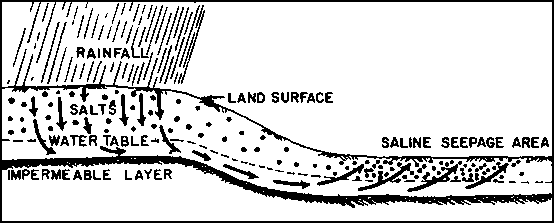|
Soil Too Salty for Crops

Photo courtesy of Montana Salinity Control
Association
Too salty . . .
This aerial photo was taken over Interstate Highway #15 near
Power, Montana (25 miles northwest of Great Falls). The white
patches to the right of the highway are areas where the soil has
been damaged by saline seep, a problem that has ruined more
than 300,000 acres of farmland in Montana. The word "saline"
refers to the salts (mostly sodium and magnesium sulfate salts)
that build up at the surface, making it difficult for crops to grow
there.
In a nutshell . . .
The diagram below illustrates how saline seep typically occurs.
Water soaks into the ground at the "recharge area". Excess
water that is not absorbed by plants moves (percolates)
downward through the soil. On its way it dissolves (leaches)
mineral salts. In the diagram, the salt-laden groundwater
reaches an impermeable layer and then migrates to a lower area
where the water table is at the surface. At this "discharge area",
the water evaporates, leaving the salts behind as a white crust
on the surface.
 "Summer Fallow" is the
culprit . . .
Although sodium and magnesium sulfates (salts) occur naturally,
saline seep is usually not natural occurrence. In Montana the
problem is often related to a "crop-fallow" system of farming.
With this type of farming, every other year a strip of land is kept
barren of vegetation by plowing and/or using herbicides in order
to allow soil moisture to build up and eliminate weeds. On these
strips, called "summer fallow", there are no plants to absorb the
water from rain or melted snow, so it more easily soaks through
the soil, leaching salts along the way and causing an elevated
water table.
Term: summer fallow
| 








